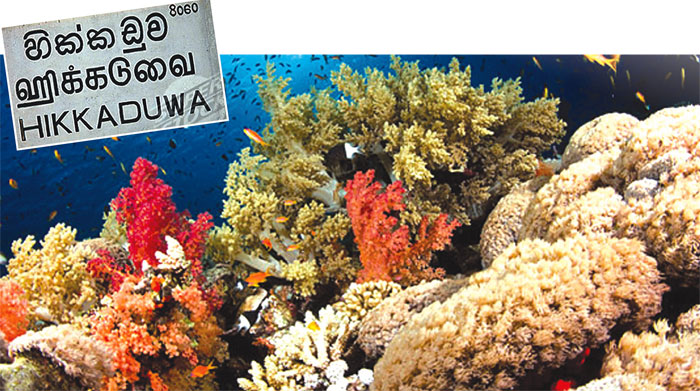Variety
Place names - what they tell us
Hikkaduwa immediately brings to mind tourists, coral gardens and
glass-bottomed boats. This same coral reef that has made Hikkaduwa
famous, has given the place its name. The place was once, not just a
coral garden, but also a jungle of corals, and that is just what
Hikkaduwa means - a coral jungle.
In the Sandesa poems of the 15th century, the place is mentioned as ‘Sipkaduwa.’
The birds carrying messages to God Upulvan in Devinuwara, were
invariably asked to pause at Sip Kaduwa - the coral or shell jungle.
‘Sippi’ which, as most of you know, means sea-shell. It has been
shortened to ‘sip’ and kaduwa is jungle. This kaduwa has nothing to do
with that other ‘kaduwa’ (sword) wielded by the English-speaking folk
and which has lent its name to the mountain pass on the road to Kandy.

Kaduwa meaning jungle occurs in many place names viz. Parakaduwa,
Waskaduwa and Rathmalkaduwa. The pass on the Matale-Kandy road is at
Balakaduwa and Elkaduwa is not far away.
Kaduwa, is a derivative of Kadu, a Tamil word for forests, and Katu
is a variant of Kadu. So, Thimbirigaskatuwa, a suburb of Negombo may
have once been a jungle of thimbiri trees.
Tamil derivatives in place names in Sinhala areas are not uncommon,
just as some place names in the northern peninsular are corruptions of
Sinhala names. Chunnakam and Kodigamam were once Sunugama and Godigamuwa
and Vaddukottai is a corruption of Batukotuwa.
Panadure, (now written Panadura in nameboards) on the west coast and
Sammanthurai on the east coast are as far apart as any two towns in Sri
Lanka could be. But they are closer in meaning than neighbouring towns.
The ending ‘dure’, in Panadure is the same as ‘thurai’ in Tamil and both
are derived from theertha, a Sanskrit word for port.
Panadure or Panadura, is no longer a port but in the 15th century
sailing vessels were calling frequently at Panadure. In the Sandesa
poems we get glimpses of the countryside in the 14th and 15th centuries.
The Gira Sandesaya describes the boats with their dark sails, coming
into or leaving Panadure.
Unlike the link between Panadure and Sammanthurai which is vague, the
link between Nalluruwa within the town limits of Panadura, and Nallur,
where the famous Kandasamy Kovil located is unmistakable.
They are both ‘good settlements.’ Sailors who came from South India
to the Jaffna peninsular must have stayed in that area and found it a
very suitable place. Hence, they may have called the place Nallur which
became Nalluruwa on the Sinhala tongue.
Like the Tamil thurai, the generic ending ‘tara’ in many Sinhala
place names goes back to the Sanskrit ‘theertha’ - port. Towns and
villages known by names with this generic ending are as a rule situated
on the banks of rivers and these must, at one time, been fords. Let’s
take a quick run down the South Western coast. There is Kalutara on the
estuary of the Kalu Ganga, Bentara on the Ben Ganga (in popular parlance
Bentara Ganga) and Welitara on the Madu Ganga and on the South coast
there is Matara at the mouth of the Nilwala Ganga.
Also common on the coast line are places with names ending in tota, a
generic name for ford or harbour. Bentara is also known as Bentota, and
further South, near Galle, is Gintota.
At the South Eastern end of the coast we pass Ambalantota and
Hambantota. Ambalantota has got its name from the many ‘ambalam’ or
rest-rooms at the ford where people waited until the boats were ready to
sail. Hambantota was the harbour at which the ‘hamban’ or the Chinese
Sampan called.
A combination of a generic term and a specific term is a principle
followed in naming places, in most countries and it is so in Sri Lanka
too, the specific preceeding the generic. The generic term usually
refers to some natural feature by which the first settlers referred to
their settlement, and so we have place names like ‘pallama’ - hill
slope, and modera, mouth of a river. When people first settled down near
the mouth of the Kelani Ganga, on its south bank, the settlement would,
quite naturally, have been called Modara by the settlers - mouth of the
river. In course of time the common noun became a proper noun.
The name of the village which is now a part of the city of Colombo.
There are other Moderas down the S.W. Coast and they are all at or
close to the mouth of rivers, and each has a descriptive element to
distinguish it from other Moderas, not far away. There is Maha Modera, a
northern suburb of Galle, as distinct from Seenimodera or the smaller
modera and Kaluwamodera.
Many place names on the coast line have the generic ending ‘wella’ -
beach, and they are all distinguished by some specific term descriptive
of some outstanding quality of the generic, like Kaluwella black beach,
Dikwella long beach and Kudawella, small beach. Suduwella - white beach,
is a ward in the Colombo Municipality. The area where St. Joseph’s
College is Suduwella. The beach of the Beira Lake must have been at one
time a vast stretch of white sand.
When the original meaning of a word is lost or forgotten, either
through constant usage or because the word has undergone phonetic
changes, people begin to explain the word through folk etymology or
change the pronunciation, on the analogy of words in current use. I have
heard the name Pamankada, a large word in the Colombo Municipality
pronounced as Pamankaday, on the mistaken notion that the second part of
the name refers to a boutique or little shop. Pamankada and Kochchikade
should not be classed together.
Here ‘kada’ means a strip, and ‘mankada’ is a passage or narrow path.
So, Pamankada is a narrow foot path. Pa is a derivative of
paada-foot.Alimankada in the north is Elephant Pass.
-Sumana SAPARAMADU |


